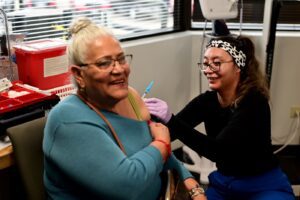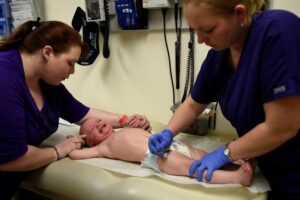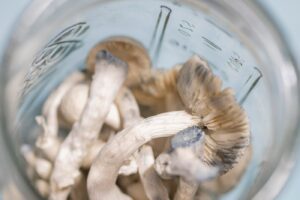A 21-year-old woman presents to a college health clinic with complaints of bruising easily. Reporting that the bruising began 3 weeks ago, the patient says she first noticed it on her distal arms after playing volleyball. She reports that the bruising never occurred before, although she played 8 years of volleyball including at college.
A review of systems is positive for bleeding gums, frequent nosebleeds, heavy periods, spotting between menstrual cycles, and a petechial rash on both legs. The patient reports that the rash developed after she was running. She also reports that running has become difficult and complains of a progressive decrease in exercise tolerance.
She denies fever, night sweats, weight loss, headaches, abdominal pain, fainting, dizziness, lightheadedness, chest pain, shortness of breath, blood in her stool or urine, and recent illness. Her last menstrual period was 2 weeks ago, and she denies any chance of pregnancy. She denies use of illicit drugs or any new prescription or over-the-counter medications and has no known drug allergies.
Continue Reading
The patient is taking a contraceptive containing norgestimate and ethinyl estradiol. She has a medical history of iron-deficiency anemia but is not taking iron supplements. Her family history is significant for lymphomatoid granulomatosis (a rare lymphoma) in her paternal grandfather and leukemia in a maternal first cousin.
On presentation, the student appears well and is alert and oriented. Vital signs are normal (Table 1).

Physical examination reveals ecchymosis on the distal dorsal arms and the proximal medial legs bilaterally (Figure 1). Petechial spotting is noted on both lower extremities, as well as orally along the gum line (Figure 2). Heart sounds show a normal rate and rhythm without murmur, and lungs are clear to auscultation. She has no lymphadenopathy, abdominal tenderness, or palpable hepatosplenomegaly.

Outpatient laboratory testing is conducted immediately and shows a critically low platelet count and low hemoglobin, hematocrit, mean corpuscular volume, mean corpuscular hemoglobin, and ferritin (Table 2). Trace hemoglobin is detected in the urinalysis. Peripheral blood smear reveals severe thrombocytopenia and mild microcytic anemia, with no morphologic abnormalities.

The patient’s white blood cell count, comprehensive metabolic panel, erythrocyte sedimentation rate, C-reactive protein level, tick-borne disease panel, prothrombin time/international normalized ratio, antinuclear antibody test, human chorionic gonadotropin test, and vitamin D, vitamin B12, and folate levels are normal.
Conditions considered in the differential diagnosis include trauma, anemia, infections such as mononucleosis or meningitis, Henoch-Schönlein purpura, drug-induced thrombocytopenia, immune thrombocytopenia (ITP), vasculitis, coagulopathies, myelodysplastic syndromes, and leukemia.
Discussion
The patient’s medical history, examination findings, and test results suggest a diagnosis of ITP (previously known as idiopathic thrombocytopenic purpura), which is a common autoimmune disease characterized by low platelet count (9/L) and an increased risk for bleeding.1,2 Immune thrombocytopenia may present as an isolated thrombocytopenia or occur in the setting of additional autoimmune cytopenias (Evans syndrome), as a manifestation of a primary immunodeficiency, or secondary to an autoimmune condition or infection.2
This article originally appeared on Clinical Advisor





